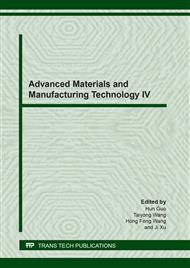[1]
Hanada T, Negishi T, Shiroishi I, et al. Plastic substrate with gas barrier layer and transparent conductive oxide thin film for flexible displays[J].Thin Solid Films,2010,518(11) 3089-3092.
DOI: 10.1016/j.tsf.2009.09.166
Google Scholar
[2]
Ju S, Li J, Liu J, et al. Transparent active matrix organic light-emitting diode displays driven by nanowire transistor circuitry [J]. Nano.Lett., 2008,8 (4) 997-1004.
DOI: 10.1021/nl072538+
Google Scholar
[3]
Logothetidis S, Laskarakis A. Towards the optimization of materials and processes for flexible organic electronics devices [J]. The European Physical Journal Applied Physics, 2009,46(1) 12502(1-9).
DOI: 10.1051/epjap/2009041
Google Scholar
[4]
Sekitani T, Nakajima H, Maeda H, et al. Stretchable active-matrix organic light-emitting diode display using printable elastic conductors[J].Nature Materials,2009,8(6) 494-499.
DOI: 10.1038/nmat2459
Google Scholar
[5]
Bae S, Kim H, Lee Y, et al. Roll-to-roll production of 30-inch graphene films for transparent electrodes [J]. Nature Nanotechnology, 2010, 5(8) 574-578.
DOI: 10.1038/nnano.2010.132
Google Scholar
[6]
Someya T. Flexible electronics: Tiny lamps to illuminate the body [J]. Nature Materials, 2010, 9(11) 879-880.
DOI: 10.1038/nmat2886
Google Scholar
[7]
XU Zheng, SONG Dan-dan, ZHAO Su-ling, et al. The Developments and Challenges in OLED, Flexible and See-through Display Technologies, and Organic Luminescent Materials. Advanced Display, 2009,101(6) 5-10.
Google Scholar
[8]
Sugimoto Akira, Ochi Hideo, Fujimure Soh, et al. Flexible OLED displays using plastic substrates [J] IEEE J Sel Top Quantum Electron, 2004, 10(1) 107-114.
DOI: 10.1109/jstqe.2004.824112
Google Scholar
[9]
Bardsley J N. International OLED technology roadmap [J]. IEEE J Sel Top Quantum Electron, 2004, 10(1) 3-9.
Google Scholar
[10]
Xie zhiyuan,Hung Liangsun,Zhu Furong.A flexible top-emitting organic light-emitting diode on steel foil[J]. Chem Phys Lett ,2003,381(5/6) 691-696.
DOI: 10.1016/j.cplett.2003.09.147
Google Scholar
[11]
Liu Haiyan. Performance and Test of Glass Substrate for TFT-LCD. Glass, 2009,36 (1) 22-24.
Google Scholar
[12]
WANG Yue, MAN Rui-lin, LIANG Yong-huang, et al. Progress in Research on Surface Polishing Technologies for Stainless Steel. Electroplating & Pollution Control, 2012,32(2) 1-4.
Google Scholar
[13]
K.P. Han, J.L. Pang. Chemical Polishing for Stainless Steel. Journal of the Electrochemical Society of India. 1996, 45 (1) 50-52.
Google Scholar
[14]
H. Keping, F. Jingli. Study on chemical polishing for stainless steel. Transactions of the Institute of Metal Finishing, 1998.76 (1) 24-25.
DOI: 10.1080/00202967.1998.11871186
Google Scholar
[15]
YAO Ying-wu,QIU Li,ZHAO Chun-mei,et al. Chemical Polishing Technology of Stainless Steel. Plating & Finishing, 2010,32(9) 5-8.
Google Scholar
[16]
Xiaokai Hu,Zhitang Song,Fei Qin,et al. Chemical mechanical polishing of stainless steel foil as flexible substrate. Applied Surface Science, 2012 ,258(15) 5798-5802.
DOI: 10.1016/j.apsusc.2012.02.100
Google Scholar
[17]
ZHENG Hai-feng,WEI Xin,XIE Xiao-zhu, et al. Research on process temperature during chemical mechanical polishing of stainless steel substrate. Diamond & Abrasives Engineering, 2014,34(2) 20-24.
Google Scholar
[18]
Jianxiu Su, Jiapeng Chen, Haifeng Cheng. Analysis on the influence of oxidant in CMP of ultra-thin stainless steel [J].Advanced Materials Research ,1027 (2014) 167-170.
DOI: 10.4028/www.scientific.net/amr.1027.167
Google Scholar
[19]
Jiapeng Chen, Jianguo Yao, Lijie Ma, et al. Study of the Slurry in CMP 304 Ultra-Thin Stainless Steel Surface[J].Advanced Materials Research,1027 (2014) 235-239.
DOI: 10.4028/www.scientific.net/amr.1027.235
Google Scholar
[20]
CHEN Jiapeng, Chen Shaokun, Li Qing,et al. Study on chemical mechanical polishing of 304 stainless steel sheet based on alkaline polishing slurry. Diamond & Abrasives Engineering, 2016,36(2) 6-9.
Google Scholar
[21]
Lin Bin-Tiao,Chen C.S., Yeh W.K. Surfactant behavior and study in slurry. IEEE/SEMI advanced semiconductor manufacturing conference. 2002:362-367.
DOI: 10.1109/asmc.2002.1001634
Google Scholar


